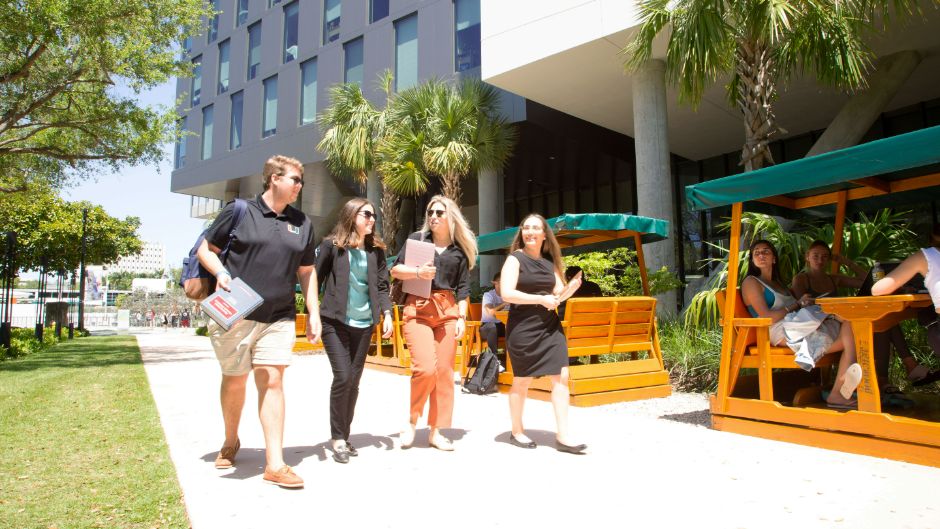Law school admissions is an increasingly competitive endeavor, with applicants bringing a diverse range of lived experiences to institutions across the country. Law schools receive thousands of applications each cycle, with far fewer seats available in the entering class.
In whichever category an applicant finds themselves — waitlist, reapplicant, or transfer — they must critically evaluate the quality and strength of their application to maximize their chances of earning a law degree from the school that best fits their goals.
The Law Admissions Waitlist
Placement on a law admissions waitlist is neither an acceptance nor a rejection. The admissions committee places applicants on the waitlist when they cannot extend an offer of admission at the time of review but remain interested in the applicant’s file.
Miami Law understands the uncertainty accompanying the waitlist and urges applicants to use sound judgment in their communications with any law school. Unlike other aspects of the admissions process, waitlist movement is largely out of the Office of Admissions’ control and depends upon decisions made by admitted students.
Ways to Supplement a Waitlisted Application
Waitlisted applicants can supplement their applications by submitting relevant documentation supporting their file, including a new LSAT score (or GRE/JD-Next score), an updated resume, a letter of continued interest, an additional letter of recommendation, or any other addendum that reflects positively upon the applicant’s law school qualifications.
The admissions committee makes offers of admission as space in the class becomes available, and Miami Law notifies applicants immediately if there is any change in their status.
Chances of Movement Off a Waitlist
An admissions office cannot predict the percentage of applicants who will be accepted from the waitlist as that number varies each cycle. However, most waitlist movement occurs during the summer, between the second seat deposit deadline in June and orientation week in mid-August.
Waitlisted applicants may receive a scholarship but must keep in mind that scholarship funding rapidly decreases as the cycle progresses. The scholarship fund may be exhausted by the time a waitlisted applicant receives their acceptance.
Miami Law is committed to transparency and fairness throughout the waitlist process and encourages applicants to move forward with arrangements to attend another law school, as there is no guarantee an applicant will gain admission from the waitlist. For additional information, please see Miami Law’s Waitlist Q&A.
Reapplying to Law School
Applicants may choose to reapply to law school, regardless of whether they received offers of admission during a previous application cycle. Submitting a stronger application can increase an applicant’s competitiveness at a broader range of schools and improve their chances of earning a scholarship.
At Miami Law, the admissions committee carefully and thoroughly reviews each applicant’s file. There is no disadvantage to applying as a reapplicant with respect to both admissions and scholarships.
Importance of Submitting a Stronger Application
For those reapplying after an unsuccessful application cycle, it is imperative to assess weaknesses in the previous application critically. Submitting the same application with no significant changes will likely result in the same outcome.
For applicants whose academic credentials were below Miami Law’s medians, particularly below the 25th percentile, consider retaking the LSAT after further preparation. Reapplicants should apply early in the cycle (before Miami Law’s priority deadline), revise their personal statement, and gain additional professional experience. Review our “What Are My Chances” article for greater detail on submitting a strong application.
Transferring Law Schools
Many first-year law students contemplate transferring to a school that more closely aligns with their personal and professional aspirations. Miami Law never recommends enrolling in a law school with the intent to transfer. Law school is challenging, and a student’s first-year performance may not result in a competitive law school GPA. Furthermore, transferring to another law school is more difficult than transferring between undergraduate universities, and the percentage of admitted transfer applicants varies with each cycle.
The Keys to Planning for Transfer Applications
The law school application process requires careful planning and proper timing for law students who ultimately decide to transfer. Law students with above a 3.0 law school GPA can apply to transfer to Miami Law after completing their first year at an ABA-accredited institution.
Several components of the transfer application review process resemble the initial law school application review process. For example, the Admissions Committee evaluates a transfer applicant’s standardized test scores, undergraduate academic record, personal statement, and resume.
Impact of First-Year Law School Grades
First-year grades is one of the notable differences in a transfer application. The admissions committee focuses heavily on a transfer applicant’s first-year law school performance. Competitive transfer applicants should have at least a 3.0 law school GPA and must submit their class rank and a letter of good standing as part of their application.
Miami Law strongly recommends a law professor write the required letter of recommendation. Importantly, transfer applicants are not eligible for merit-based scholarships but may still apply for financial aid.
Take Note of How Transfers Are Integrated
Before enrolling at a new institution, determine how the law school integrates transfer students into its class. Prospective transfer applicants should confirm their ability to participate in a law journal, moot court, on-campus Interviews, clinics, joint degree programs, and other curricular and extracurricular offerings.
At Miami Law, transfer students can take advantage of all these opportunities and more during their second or third years at the law school. Consult the JD Transfer Application Process page and the article on “8 Considerations to Choosing a Law School” for insights into everything Miami Law offers.
Whether from the waitlist, as a reapplicant, or a transfer student, we hope to welcome you to Miami Law. We look forward to meeting with you and welcoming you. When you are ready to apply, review our application overview and our transfer application instructions.

